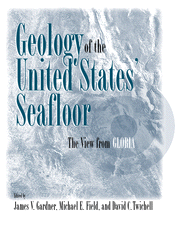Book contents
- Frontmatter
- Contents
- Contributors
- Foreword
- Introduction
- Part I The GLORIA System and Data Processing
- Part II U. S. East Coast EEZ
- Part III Gulf of Mexico and Caribbean EEZ
- Part IV U. S. West Coast EEZ
- Part V Alaskan EEZ
- Introduction
- 15 Sediment Pathways in Gulf of Alaska from Beach to Abyssal Plain
- 16 Sedimentation Along the Fore-Arc Region of the Aleutian Island Arc, Alaska
- 17 Aleutian Basin of the Bering Sea: Styles of Sedimentation and Canyon Development
- 18 Geology of the Kula Paleo-Plate, North Pacific Ocean
- Index
15 - Sediment Pathways in Gulf of Alaska from Beach to Abyssal Plain
Published online by Cambridge University Press: 25 January 2010
- Frontmatter
- Contents
- Contributors
- Foreword
- Introduction
- Part I The GLORIA System and Data Processing
- Part II U. S. East Coast EEZ
- Part III Gulf of Mexico and Caribbean EEZ
- Part IV U. S. West Coast EEZ
- Part V Alaskan EEZ
- Introduction
- 15 Sediment Pathways in Gulf of Alaska from Beach to Abyssal Plain
- 16 Sedimentation Along the Fore-Arc Region of the Aleutian Island Arc, Alaska
- 17 Aleutian Basin of the Bering Sea: Styles of Sedimentation and Canyon Development
- 18 Geology of the Kula Paleo-Plate, North Pacific Ocean
- Index
Summary
Abstract
In the northern Gulf of Alaska large glacially formed sea valleys extend to the edge of the continental shelf and form conduits for transport of suspended sediment. GLORIA sidescan sonar imagery shows that the adjacent continental slope is devoid of large submarine canyons. A variety of mechanisms act to transport sediment to the base of the slope. From Kodiak to Middleton Island, discontinuous actively growing deformation structures trap or divert sediment transported downslope into the Aleutian Trench. In those areas where channelways continue to the trench, we observe trellised and dendritic patterns of erosion on the GLORIA imagery. Some gullies merge to form small canyons that extend to the relatively shallow (4000m) northern part of the Aleutian Trench where small fans are being constructed from debris flow and/or turbidity-current transported sediment. On the continental slope seaward of the Malaspina Glacier, small canyons and extensive gullies merge to form three turbidity-current channels, which in turn merge to form Surveyor Channel. About 350 km from the base of the slope, Surveyor Channel crosses the structural barrier formed by the Kodiak-Bowie Seamount chain and heads south another 150 km where it bends northwesterly, perhaps influenced by the oceanic basement relief of the Patton Seamounts. The now deeply entrenched channel is up to 6 km wide and 500 m deep and continues northwesterly for 200 km where it empties into the Aleutian Trench, some 700 km from the Yakutat margin.
- Type
- Chapter
- Information
- Geology of the United States' SeafloorThe View from GLORIA, pp. 255 - 278Publisher: Cambridge University PressPrint publication year: 1996
- 4
- Cited by



